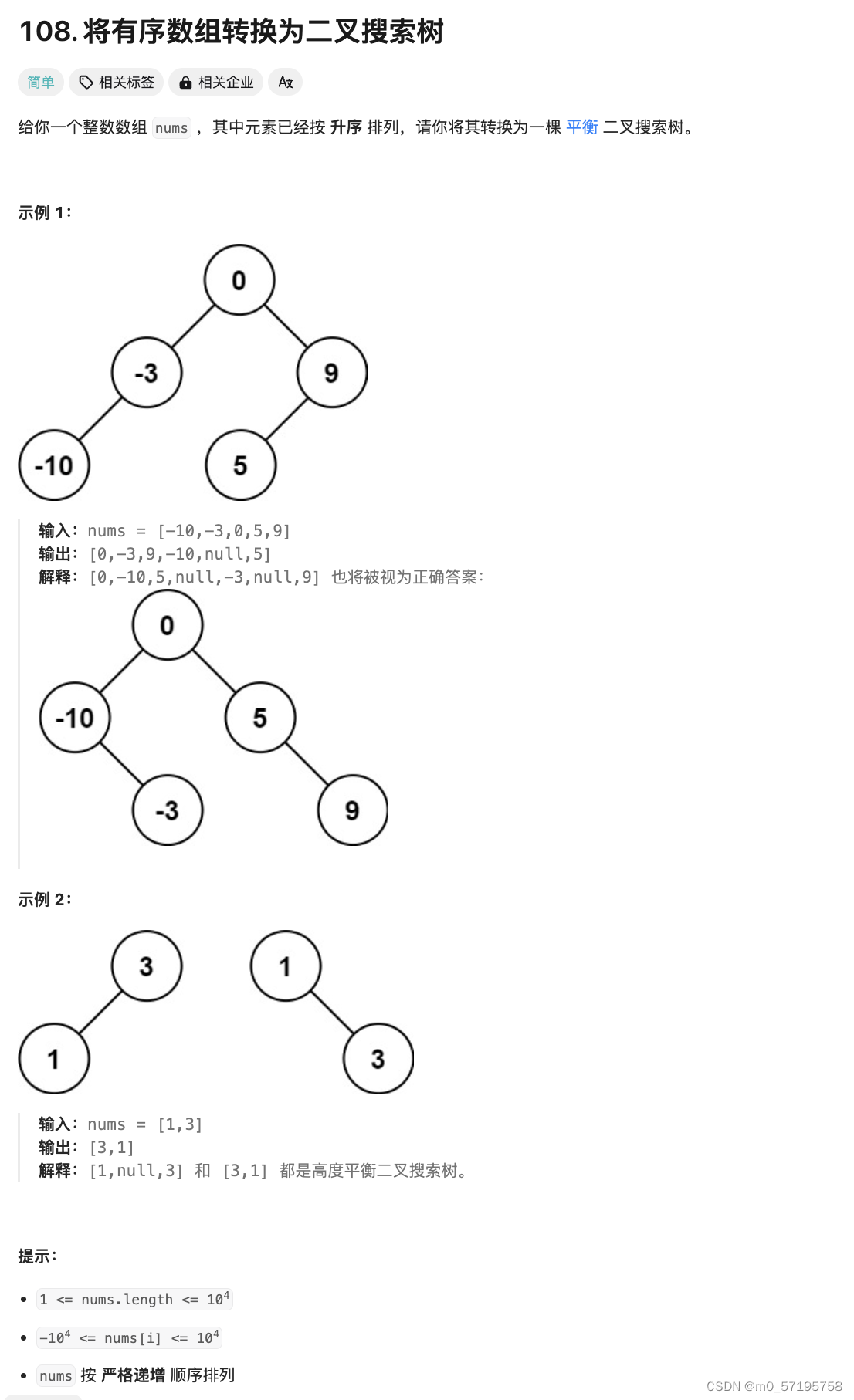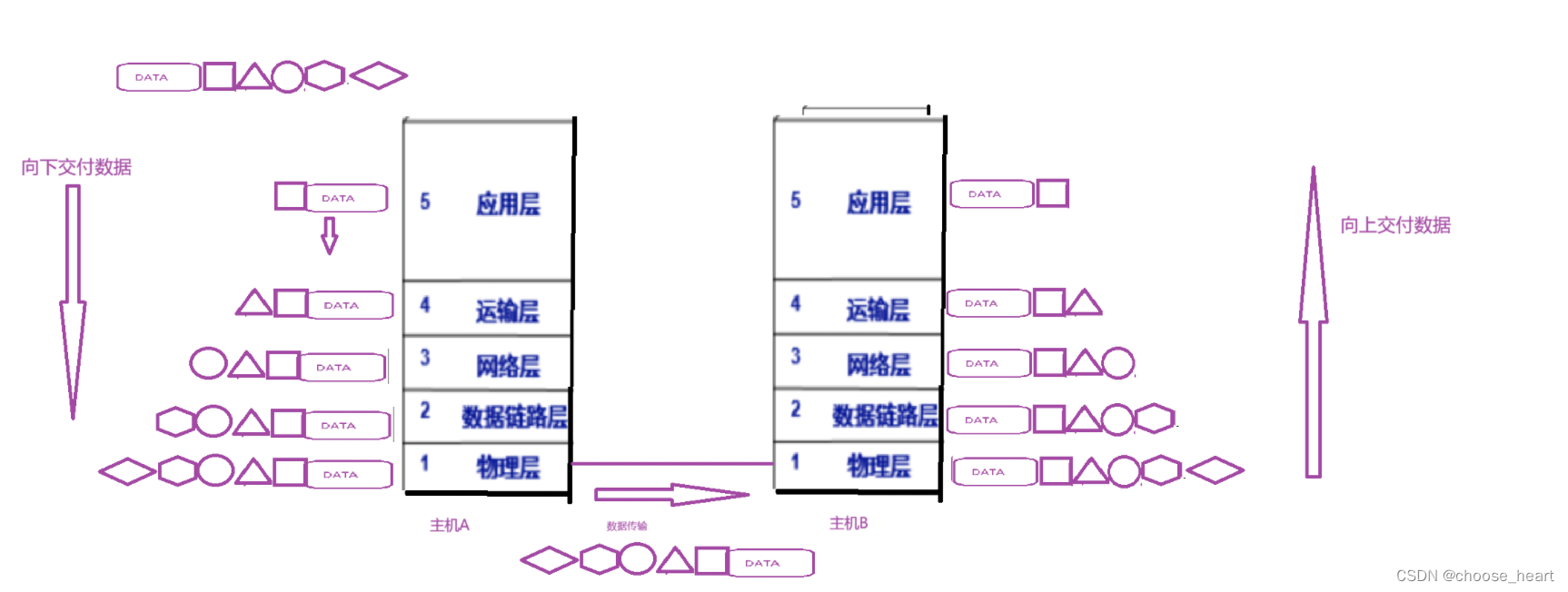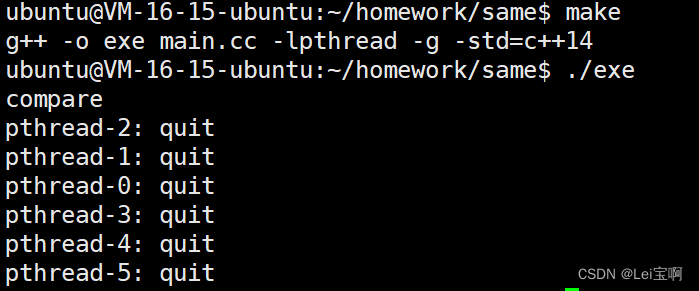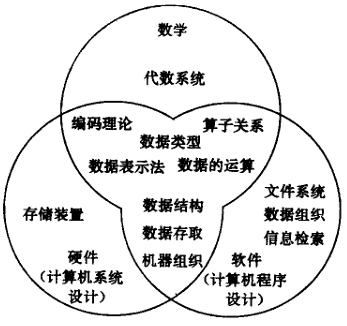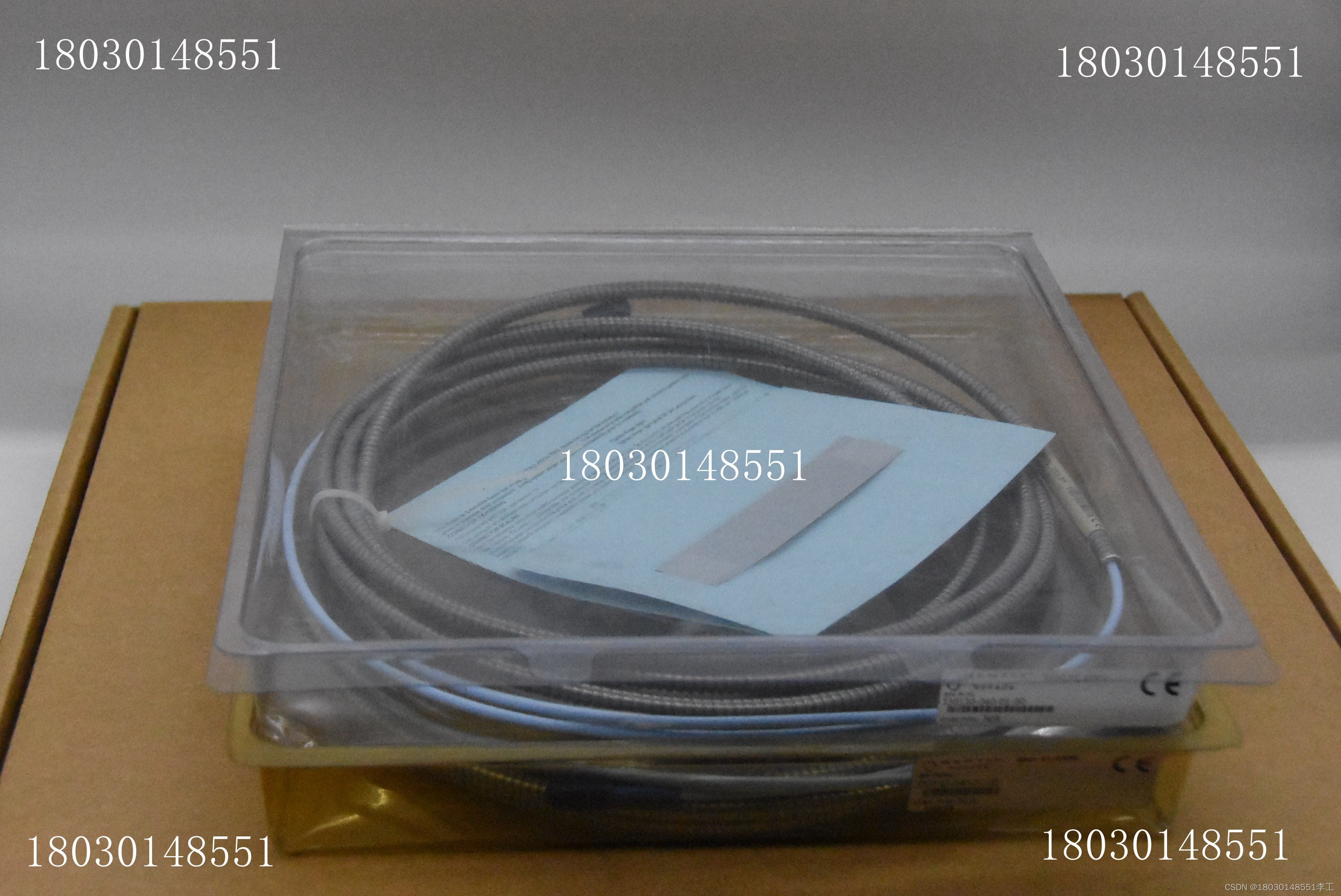上一篇:01-创建型设计模式(共6种)
1. Adapter(适配器模式)
适配器模式是一种结构型设计模式,它允许将一个类的接口转换成客户端所期望的另一个接口。这种模式通常用于解决接口不兼容的情况,使得原本由于接口不匹配而无法工作的类可以一起工作。
在 C++ 中,适配器模式可以通过类适配器和对象适配器两种方式来实现。
1.1 类适配器
使用多重继承实现适配器类,使其既继承目标接口,又继承被适配的类。
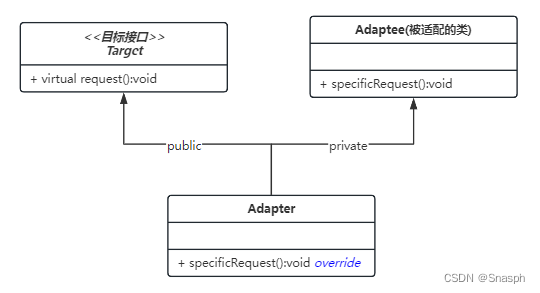
以下是模式示例:
#include <iostream>// 目标接口
class Target {
public:virtual void request() = 0;
};// 被适配的类
class Adaptee {
public:void specificRequest() {std::cout << "Specific request from Adaptee" << std::endl;}
};// 类适配器,继承目标接口和被适配类
class Adapter : public Target, private Adaptee {
public:void request() override {specificRequest(); // 调用被适配类的方法}
};int main() {Target* target = new Adapter();target->request();delete target;return 0;
}
1.2 对象适配器
使用对象组合实现适配器类,使其持有被适配的对象实例。

以下是模式示例:
#include <iostream>// 目标接口
class Target {
public:virtual void request() = 0;
};// 被适配的类
class Adaptee {
public:void specificRequest() {std::cout << "Specific request from Adaptee" << std::endl;}
};// 对象适配器,持有被适配类的对象实例
class Adapter : public Target {
private:Adaptee* adaptee;public:Adapter(Adaptee* adaptee) : adaptee(adaptee) {}void request() override {adaptee->specificRequest(); // 调用被适配类的方法}
};int main() {Adaptee* adaptee = new Adaptee();Target* target = new Adapter(adaptee);target->request();delete target;delete adaptee;return 0;
}
无论是类适配器还是对象适配器,都可以实现将目标接口和被适配类进行适配,使得客户端可以统一调用目标接口的方法,而无需直接与被适配类打交道。
2. Decorator(装饰器模式)
装饰器模式是一种结构型设计模式,它允许向现有对象添加新功能,同时又不改变其结构。这种模式通过创建包装类(装饰器)来实现,在包装类中包含一个指向被包装对象的引用,并且实现与被包装对象相同的接口。
2.1 使用继承实现装饰器模式

以下是模式示例:
#include <iostream>// 抽象组件
class Component {
public:virtual void operation() = 0;
};// 具体组件
class ConcreteComponent : public Component {
public:void operation() override {std::cout << "Concrete Component operation" << std::endl;}
};// 抽象装饰器
class Decorator : public Component {
protected:Component* component;public:Decorator(Component* comp) : component(comp) {}void operation() override {if (component != nullptr) {component->operation();}}
};// 具体装饰器A
class ConcreteDecoratorA : public Decorator {
public:ConcreteDecoratorA(Component* comp) : Decorator(comp) {}void operation() override {Decorator::operation();addBehaviorA();}void addBehaviorA() {std::cout << "Added behavior A" << std::endl;}
};// 具体装饰器B
class ConcreteDecoratorB : public Decorator {
public:ConcreteDecoratorB(Component* comp) : Decorator(comp) {}void operation() override {Decorator::operation();addBehaviorB();}void addBehaviorB() {std::cout << "Added behavior B" << std::endl;}
};int main() {Component* component = new ConcreteComponent();Component* decoratedA = new ConcreteDecoratorA(component);Component* decoratedB = new ConcreteDecoratorB(decoratedA);decoratedB->operation();delete decoratedB;delete decoratedA;delete component;return 0;
}
2.2 使用组合实现装饰器模式
当使用组合实现装饰器模式时,装饰器类将持有一个对被装饰对象的引用,并在其基础上添加额外的功能
#include <iostream>// 抽象组件
class Component {
public:virtual void operation() = 0;
};// 具体组件
class ConcreteComponent : public Component {
public:void operation() override {std::cout << "Concrete Component operation" << std::endl;}
};// 抽象装饰器
class Decorator : public Component {
protected:Component* component;public:Decorator(Component* comp) : component(comp) {}void operation() override {if (component != nullptr) {component->operation();}}
};// 具体装饰器A
class ConcreteDecoratorA : public Decorator {
public:ConcreteDecoratorA(Component* comp) : Decorator(comp) {}void operation() override {Decorator::operation();addBehaviorA();}void addBehaviorA() {std::cout << "Added behavior A" << std::endl;}
};// 具体装饰器B
class ConcreteDecoratorB : public Decorator {
public:ConcreteDecoratorB(Component* comp) : Decorator(comp) {}void operation() override {Decorator::operation();addBehaviorB();}void addBehaviorB() {std::cout << "Added behavior B" << std::endl;}
};int main() {Component* component = new ConcreteComponent();Decorator* decoratedA = new ConcreteDecoratorA(component);Decorator* decoratedB = new ConcreteDecoratorB(decoratedA);decoratedB->operation();delete decoratedB;delete decoratedA;delete component;return 0;
}
 3. Proxy(代理模式)
3. Proxy(代理模式)
代理模式是一种结构型设计模式,它允许通过一个代理对象控制对另一个对象的访问。代理模式可以用于各种场景,例如:远程代理、虚拟代理、保护代理等,以实现对目标对象的访问控制、延迟加载、缓存等功能。
在 C++ 中,代理模式可以通过以下方式实现:
①. 虚拟代理(Virtual Proxy):延迟加载对象,在需要时才真正创建对象。
②. 保护代理(Protection Proxy):控制对象的访问权限,提供额外的安全性。
③. 远程代理(Remote Proxy):在不同地址空间中代表对象,实现远程通信。
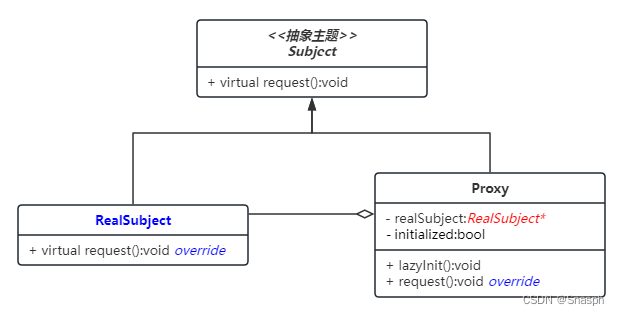
以下是模式示例:
#include <iostream>
#include <string>// 抽象主题
class Subject {
public:virtual void request() = 0;
};// 具体主题
class RealSubject : public Subject {
public:void request() override {std::cout << "Real Subject request" << std::endl;}
};// 代理类
class Proxy : public Subject {
private:RealSubject* realSubject;bool initialized;public:Proxy() : realSubject(nullptr), initialized(false) {}void request() override {if (!initialized) {lazyInit();}realSubject->request();}void lazyInit() {std::cout << "Proxy initializing..." << std::endl;realSubject = new RealSubject();initialized = true;}
};int main() {Proxy proxy;proxy.request();return 0;
}
在上面的示例中,Subject 是抽象主题类,定义了对实际主题进行操作的接口。RealSubject 是具体主题类,实现了真正的业务逻辑。Proxy 是代理类,延迟初始化 RealSubject 对象,并在需要时调用其方法。
当运行主函数时,代理对象首先进行了延迟初始化(虚拟代理的特性),然后通过代理对象调用实际主题的方法,实现了对实际主题的代理访问。
4. Composite(组合模式)
组合模式是一种结构型设计模式,它允许将对象组合成树形结构以表示“部分-整体”的层次关系。组合模式使得客户端可以统一处理单个对象和对象组合,从而使得客户端代码更加简单且具有一致性。
在 C++ 中,组合模式通常涉及以下几个角色:
①. Component(组件):是组合中的对象声明接口,在适当的情况下,实现所有类共有接口的缺省行为。可以是抽象类或接口。
②. Leaf(叶子节点):是组合中的叶节点对象,它没有子节点。
③. Composite(复合节点):是组合中的复合对象,它有子节点。通常实现了在 Component 接口中定义的操作,这些操作可以通过递归调用子节点来实现。

以下是模式示例:
#include <iostream>
#include <string>
#include <vector>// 抽象组件类
class Component {
public:virtual void operation() const = 0;
};// 叶子节点类
class Leaf : public Component {
private:std::string name;public:Leaf(const std::string& name) : name(name) {}void operation() const override {std::cout << "Leaf " << name << " operation" << std::endl;}
};// 复合节点类
class Composite : public Component {
private:std::vector<Component*> children;public:void add(Component* component) {children.push_back(component);}void remove(Component* component) {// 省略移除逻辑}void operation() const override {for (Component* child : children) {child->operation();}}
};int main() {Leaf leafA("A");Leaf leafB("B");Composite composite;composite.add(&leafA);composite.add(&leafB);composite.operation();return 0;
}
在上述示例中,我们定义了 Component 抽象组件类,Leaf 叶子节点类和 Composite 复合节点类。叶子节点表示组合中的最终节点,而复合节点表示可以包含子节点的节点。在 main 函数中,我们创建了两个叶子节点 leafA 和 leafB,然后将它们添加到了复合节点 composite 中,最后通过复合节点的 operation 方法调用了所有子节点的 operation 方法,实现了对整个组合结构的统一处理。
5. Facade(外观模式)
外观模式是一种结构型设计模式,它提供了一个统一的接口,用于访问子系统中的一群接口。外观模式定义了一个高层接口,这个接口使得子系统更容易使用。
在 C++ 中,外观模式通常包括以下几个角色:
①. Facade(外观):对客户端提供简单的接口,隐藏了系统的复杂性,提供了对子系统的统一访问接口。
②. Subsystems(子系统):包含了一组相关的类和接口,实现了系统的功能。

以下是模式示例:
#include <iostream>// 子系统A
class SubsystemA {
public:void operationA() const {std::cout << "SubsystemA operation" << std::endl;}
};// 子系统B
class SubsystemB {
public:void operationB() const {std::cout << "SubsystemB operation" << std::endl;}
};// 子系统C
class SubsystemC {
public:void operationC() const {std::cout << "SubsystemC operation" << std::endl;}
};// 外观类
class Facade {
private:SubsystemA subsystemA;SubsystemB subsystemB;SubsystemC subsystemC;public:void operation() const {subsystemA.operationA();subsystemB.operationB();subsystemC.operationC();}
};int main() {Facade facade;facade.operation();return 0;
}
6. Bridge(桥接模式)
桥接模式是一种结构型设计模式,它将抽象部分与其实现部分分离,使它们可以独立变化,从而达到解耦的目的。桥接模式通过组合而不是继承的方式来实现这种分离。
在 C++ 中,桥接模式通常涉及以下几个角色:
①. Abstraction(抽象类):定义抽象部分的接口,并维护一个对实现部分对象的引用。
②. Implementor(实现类接口):定义实现部分的接口,它与抽象部分接口保持一致。
③. ConcreteImplementor(具体实现类):实现实现类接口,提供具体的实现。
④. RefinedAbstraction(扩充抽象类):扩展抽象部分的接口,通常通过组合的方式来调用实现部分的方法。

以下是模式示例:
#include <iostream>// 实现类接口
class Implementor {
public:virtual void operationImpl() const = 0;
};// 具体实现类A
class ConcreteImplementorA : public Implementor {
public:void operationImpl() const override {std::cout << "Concrete Implementor A operation" << std::endl;}
};// 具体实现类B
class ConcreteImplementorB : public Implementor {
public:void operationImpl() const override {std::cout << "Concrete Implementor B operation" << std::endl;}
};// 抽象类
class Abstraction {
protected:Implementor* implementor;public:Abstraction(Implementor* impl) : implementor(impl) {}virtual void operation() const = 0;
};// 扩充抽象类
class RefinedAbstraction : public Abstraction {
public:RefinedAbstraction(Implementor* impl) : Abstraction(impl) {}void operation() const override {implementor->operationImpl();}
};int main() {Implementor* implA = new ConcreteImplementorA();Implementor* implB = new ConcreteImplementorB();Abstraction* abs1 = new RefinedAbstraction(implA);Abstraction* abs2 = new RefinedAbstraction(implB);abs1->operation();abs2->operation();delete abs2;delete abs1;delete implB;delete implA;return 0;
}
在上述示例中,定义了 Implementor 实现类接口和两个具体实现类 ConcreteImplementorA 和 ConcreteImplementorB。然后定义了抽象类 Abstraction,它维护了一个对实现类的引用,并定义了抽象方法 operation。最后,定义了扩充抽象类 RefinedAbstraction,它通过组合的方式调用了实现类的方法。
在 main 函数中,创建了具体实现类的对象,并将其传递给扩充抽象类,通过调用 operation 方法来间接调用具体实现类的方法,从而实现了抽象部分与实现部分的解耦。
7. Flyweight(享元模式)
享元模式(Flyweight Pattern)是一种结构型设计模式,它旨在通过共享对象来减少内存使用和提高性能。该模式适用于存在大量相似对象,且这些对象可以共享部分状态的情况。
在 C++ 中,享元模式通常涉及以下几个角色:
①. Flyweight(享元接口):定义共享对象的接口,可以接受外部状态作为参数。
②. ConcreteFlyweight(具体享元类):实现享元接口,并存储内部状态。具体享元类通常是可共享的。
③. UnsharedConcreteFlyweight(非共享具体享元类):如果享元对象不可共享,则创建非共享具体享元类。
④. FlyweightFactory(享元工厂):用于创建和管理享元对象,通常实现了享元对象的池化管理。

以下是模式示例:
#include <iostream>
#include <unordered_map>// 享元接口
class Flyweight {
public:virtual void operation(int extrinsicState) const = 0;
};// 具体享元类
class ConcreteFlyweight : public Flyweight {
private:int intrinsicState;public:ConcreteFlyweight(int intrinsicState) : intrinsicState(intrinsicState) {}void operation(int extrinsicState) const override {std::cout << "Concrete Flyweight with intrinsic state " << intrinsicState;std::cout << " and extrinsic state " << extrinsicState << std::endl;}
};// 享元工厂
class FlyweightFactory {
private:std::unordered_map<int, Flyweight*> flyweights;public:Flyweight* getFlyweight(int key) {if (flyweights.find(key) != flyweights.end()) {return flyweights[key];} else {// 通过共享具有相同内部状态的享元对象,可以减少内存使用和提高性能;Flyweight* flyweight = new ConcreteFlyweight(key);flyweights[key] = flyweight;return flyweight;}}~FlyweightFactory() {for (auto& pair : flyweights) {delete pair.second;}flyweights.clear();}
};int main() {FlyweightFactory factory;Flyweight* flyweight1 = factory.getFlyweight(1);flyweight1->operation(100);Flyweight* flyweight2 = factory.getFlyweight(2);flyweight2->operation(200);Flyweight* flyweight3 = factory.getFlyweight(1);flyweight3->operation(300);delete flyweight3;delete flyweight2;delete flyweight1;return 0;
}
下一篇: 03-行为型模式(共10种)



